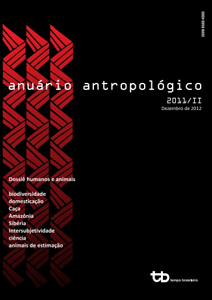Outra espécie de companhia
Intersubjetividade entre primatólogos e primatas
Keywords:
Intersubjetividade, primatólogos, humanos e não humanos, antropologia da ciênciaAbstract
This article addresses a very specific phenomenon of the relationship between animals and ethologists: intersubjectivity. The stories presented here are derived from a specifictype of literature produced by primatologists that exposes the relationship between primatologists, during their fieldwork, and its objectssubjects primates. Exploring the concept of intersubjectivity between different species (human and non-human) is intended to draw attention to elements of affection, transformation and inadequacy that make up these stories.
Downloads
References
HAUVIN, Rémy. 2000. O Homem, o Símio e a Ave. Lisboa: Instituto Piaget.
CHENEY, Dorothy L. & SEYFARTH, Robert M. 1992.How Monkeys See the World: Inside the Mind of Another Species. Chicago: University of Chicago Press.
DAWKINS, Richard. 1979. O Gene Egoísta. São Paulo: Ed. Itatiaia.
DESCOLA, Philippe. 1992. “Societies of Nature and the Nature of Society”. In: Adam Kuper (ed.).Conceptualizing Society. London & New York: Routledge.
_____. 2005. Par-de là Nature et Culture. Paris: ÉditionsGallimard.
DESPRET, Vinciane.2002.Quand le loup habitera avec l´agneau. Paris: Les Empêcheurs de penser en rond.
_____. 2004. Hans, le cheval qui savait compter. Paris: Les Empêcheurs de penser en rond.
ESTADO DE MINAS, edição de 03 de janeiro de 1993.
FOSSEY, Diane. 1983. Gorillas in the Mist. Boston: Houghton Mifflin Company.
GLOBO RURAL, ano 13, n. 149, mar. 1998.
GOODALL, Jane. 1991. Uma Janela para a Vida: 30 anos com os Chimpanzés da Tanzânia. Rio de Janeiro: Jorge Zahar Editor.
HARAWAY, Donna. 1989. Primate Visions. Gender, Race and Nature in the World of Modern Science. New York: Routledge.
INGOLD, Tim. 1993. “The Art of Translation in a Continuous World”. In: Gisli Pálsson (ed.). Beyond Boundaries: Understanding, Translation and Anthropological Discourse. Oxford/ Providence: Berg.
KOHN, Eduardo. O. 2002. Natural Engagements and Ecological Aesthetics among the Ávila Runa of Amazonian Ecuador. Tese de Doutorado, University of Wisconsin-Madison.
LATOUR, Bruno. 2000. “A Well-Articulated Primatology: Reflections of a FellowTraveller”. In: Shirley Strum & Linda Fedigan (eds.). Primate Encounters: Models of Science, Gender, and Society. Chicago: The University of Chicago Press.
_____. 2001. A Esperança de Pandora: Ensaios sobre a Realidade dos Estudos Científicos. Bauru: EDUSC.
_____ & WOOLGAR, Steve. 1997. A Vida de Laboratório: A Produção dos Fatos Científicos. Rio de Janeiro: Relume Dumará.
LÉVI-STRAUSS, Claude. 1989. O Pensamento Selvagem. Campinas: Papirus Editora.
_____. 1993. História de Lince. São Paulo: Companhia das Letras.
MORRIS, Desmond. 1967. O Macaco Nu. Rio de Janeiro: Record.
_____. 1971. A Biologia da Arte: Um Estudo Comparativo da “Arte” dos Grandes Símios com a Arte Humana. Vila da Maia: Publicações Europa-América.
_____. 1990. O Contrato Animal. Rio de Janeiro: Record.
REES, Amanda. 2009. The Infanticide Controversy: Primatology and the art of field science. Chicago: The University of Chicago Press.
SÁ, Guilherme J.S. 2009. “Estar Ciente e Fazer Ciência: Sobre Encontros e Transformações”. Campos (UFPR), n. 10 (1): 29-44.
SÁEZ, Oscar C. 2004. “Moinhos de Vento e Varas de Queixadas. O Perspectivismo e a Economia do Pensamento”. Mana, 10 (2): 227-56.
SMUTS, Barbara. 2002. “Reflexões”. In: John M. Coetzee. A Vida dos Animais. São Paulo: Companhia das Letras.
STANFORD, Craig B. 2004. Como nos Tornamos Humanos: Um Estudo da Evolução da Espécie Humana. Rio de Janeiro: Elsevier.
STOLZE LIMA, Tania. 2005. Um peixe olhou para mim: o povo Yudjá e a perspectiva. São Paulo: Editora UNESP/ISA; Rio de Janeiro: NuTI.
STRIER, Karen B. 1992. Faces in the Forest: The Endangered Muriqui Monkeys of Brazil. New York: Oxford University Press.
STRUM, Shirley. 1990. Presque Humain: Voyage chez les Babouins. Paris: Editions Eshel.
VILAÇA, Aparecida M. 1992. Comendo como Gente. Rio de Janeiro: Editora da UFRJ.
VIVEIROS DE CASTRO, Eduardo B. 1999. “Entrevista”. Sexta-feira [corpo]. São Paulo: Editora Hedral. p.112-29.
_____. 2002. A Inconstância da Alma Selvagem. São Paulo: Cosac & Naify.
Von UEXKUL, Jakob. 1957 [1934]. “A stroll into the worlds of animals and man”. In: C.H. Schiller & K.S. Lashley. Instinctive Behavior. The Development of a modern concept. New York: Internacional Universities Press, INC. P 05-08
WILSON, Edward O. 1975. Sociobiology: The New Synthesis. Cambridge: Harvard University Press.
_____. 1981. Da Natureza Humana. São Paulo: EDUSP.
Downloads
Published
How to Cite
Issue
Section
License
Copyright (c) 2012 Anuário Antropológico

This work is licensed under a Creative Commons Attribution-NonCommercial-NoDerivatives 4.0 International License.
https://creativecommons.org/licenses/by/4.0/legalcode.en
Creative Commons - Atribución- 4.0 Internacional - CC BY 4.0
https://creativecommons.org/licenses/by/4.0/legalcode.en



